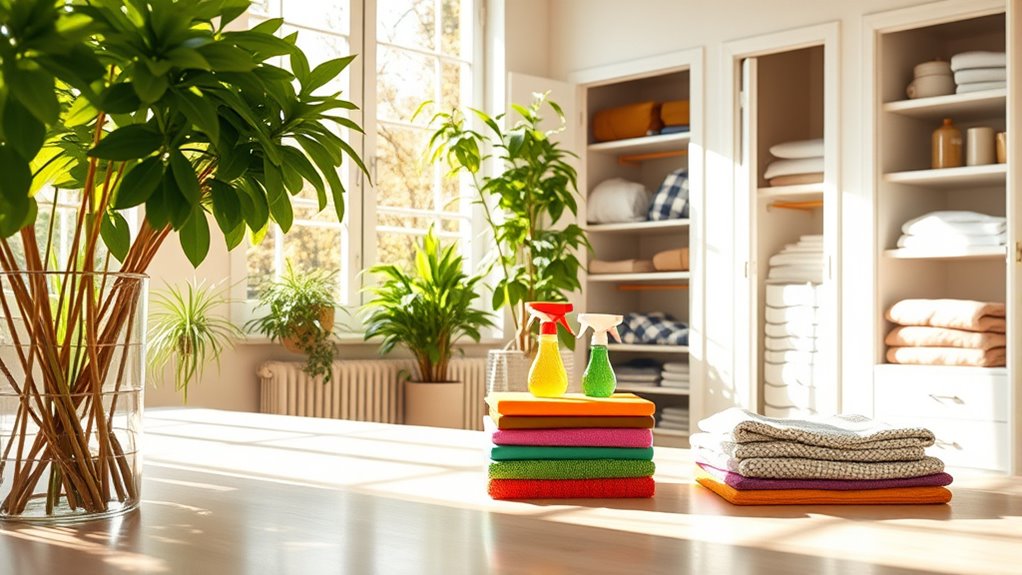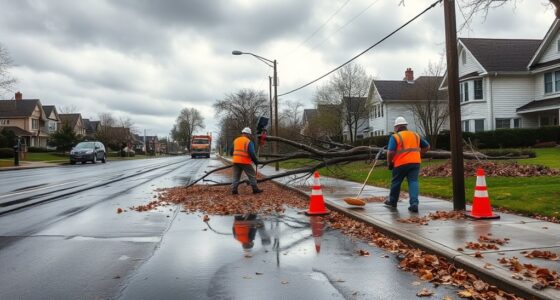To prepare your home for spring cleaning, start by decluttering each room. Use designated boxes to sort items into keep, donate, or discard. Next, gather your cleaning supplies and create a checklist of essentials. Plan a cleaning schedule, prioritizing tasks by room or category. Don’t forget to inspect safety equipment and organize your belongings. Involve family members to make the process easier and more enjoyable. There’s even more you can do for a smooth cleaning experience.
Key Takeaways
- Declutter each room by sorting items into keep, donate, and discard boxes to create a clean slate for spring cleaning.
- Gather and organize all cleaning supplies in a portable caddy, ensuring you have essential products ready for use.
- Create a detailed cleaning checklist, prioritizing tasks by room to effectively manage the spring cleaning process.
- Prepare the cleaning area by decluttering and organizing supplies for easy access, ensuring a smooth cleaning experience.
- Involve family members in the process by assigning age-appropriate tasks and turning cleaning into a fun group activity.
Declutter Each Room

As you prepare for spring cleaning, decluttering each room is an essential first step.
Start by setting up designated boxes for sorting items into categories: keep, donate, and discard. This method streamlines your process and gives you clear goals.
Set up boxes to sort items into keep, donate, and discard categories for a streamlined decluttering process.
Focus on high-traffic areas like your living room and kitchen, where clutter often accumulates. Address items that are out of place or no longer needed. Implementing vertical storage solutions can help free up additional space as you declutter, and consider adding natural elements to enhance the aesthetic of your newly organized spaces. A well-organized home can lead to reduced stress levels, creating a more serene environment.
Tackle one room at a time to avoid feeling overwhelmed, and consider setting a timer for short bursts of cleaning to keep your motivation high.
Involve family members by assigning specific tasks to foster teamwork.
Once you’ve decluttered, implement a system to maintain organization, such as labeling storage bins and returning items to their designated places after use. Additionally, consider incorporating best lifestyle products that enhance organization and functionality in your home.
Gather Your Cleaning Supplies
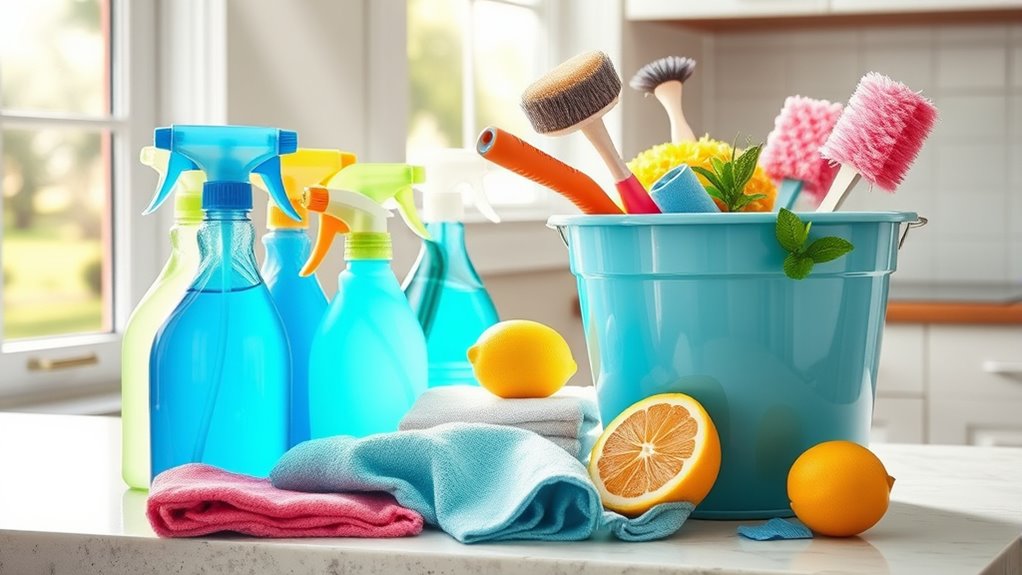
Before diving into your spring cleaning, it’s important to gather all your cleaning supplies to guarantee a smooth and efficient process.
Start by creating a cleaning checklist that includes all-purpose cleaner, disinfectant, microfiber cloths, sponges, brooms, mops, and vacuum cleaners. Additionally, consider checking out discount appliance retailers for any new cleaning gadgets that can make your task easier. Utilizing HEPA filters in your vacuum cleaner can also ensure that you’re effectively removing allergens from your home. Regularly changing vacuum cleaner attachments can enhance your cleaning efficiency for different surfaces and areas.
Don’t forget to take into account eco-friendly alternatives like vinegar, baking soda, and lemon juice, which clean effectively without harsh chemicals.
Organize your supplies in a portable caddy or bucket, making it easy to access everything while moving from room to room.
Also, stock up on disposable items like trash bags, paper towels, and gloves to streamline the cleaning process and maintain hygiene.
With everything ready, you’ll be set for a successful spring cleaning! Additionally, remember that maintaining cleanliness can support a healthier lifestyle by promoting hygiene throughout your home.
Check Outdoor Equipment

Once you’ve gathered your cleaning supplies, it’s time to turn your attention to outdoor equipment. Ensuring everything is in ideal working condition is essential for a successful spring season.
Follow these cleaning tips to help maintain your tools and gear:
- Inspect and service lawnmowers, snow blowers, and gardening tools.
- Check for necessary repairs: sharpen blades, change oil, and replace worn belts.
- Clean and store seasonal items like patio furniture and grill covers to protect them.
- Test and clean outdoor lighting fixtures for safety and visibility. Additionally, consider using safety gear such as gloves and goggles while working to protect yourself during maintenance tasks.
Additionally, consider how aging in place can influence your choice of outdoor equipment to ensure it meets your needs as you enjoy the spring season. For instance, opting for lightweight and portable options can make handling tools easier and more manageable. You might also find versatile tools that can help with various tasks, similar to how a good pasta dish can be adapted for different occasions.
Plan a Cleaning Schedule

To guarantee your spring cleaning is effective and manageable, it’s crucial to create a detailed cleaning schedule.
Start by making a thorough cleaning list of all areas and tasks that need attention. Then, prioritize tasks by room or category, spreading them over several days or weeks to keep from feeling overwhelmed. Additionally, consider assessing storage requirements in your home to identify areas that need decluttering during the cleaning process. Regular filter replacement for air purifiers during this time can also enhance air quality as you clean. Keeping a consistent routine can further improve the overall effectiveness of your cleaning efforts.
Allocate specific time slots for each task, ensuring you have enough time to complete them thoroughly. Involve family members by assigning them specific tasks or rooms, making the process more efficient and collaborative.
Use a calendar or planner to mark your cleaning days and deadlines, helping you stay accountable and on track. Following this approach, you’ll tackle spring cleaning like a cleaning expert! Additionally, incorporating regular decluttering sessions can help maintain an organized and peaceful living environment throughout the year.
Organize Your Belongings

After you’ve mapped out your cleaning schedule, it’s time to tackle the organization of your belongings. Start by eliminating clutter. Designate separate boxes for items to keep, donate, or discard to streamline the process.
Once your cleaning schedule is set, begin organizing by decluttering and sorting items into keep, donate, or discard boxes.
Tackle one room at a time, sorting through your belongings for a focused approach.
Here are some tips to help you get organized:
- Use clear bins and labels for seasonal clothing and accessories.
- Involve family members in the sorting process to encourage teamwork.
- Regularly reassess your organization system and update your storage solutions.
- Declutter items that you no longer use or need.
- Consider implementing a bedtime routine to help maintain organization and cleanliness as part of your overall home management strategy. Additionally, you may want to explore zoning laws to understand how they impact your storage options if you live in a tiny house. Using open shelving in your home can also provide an aesthetically pleasing way to keep items visible and accessible. To enhance air quality during your spring cleaning, consider using an air purifier to reduce allergens and dust in your living spaces.
Inspect Safety Equipment
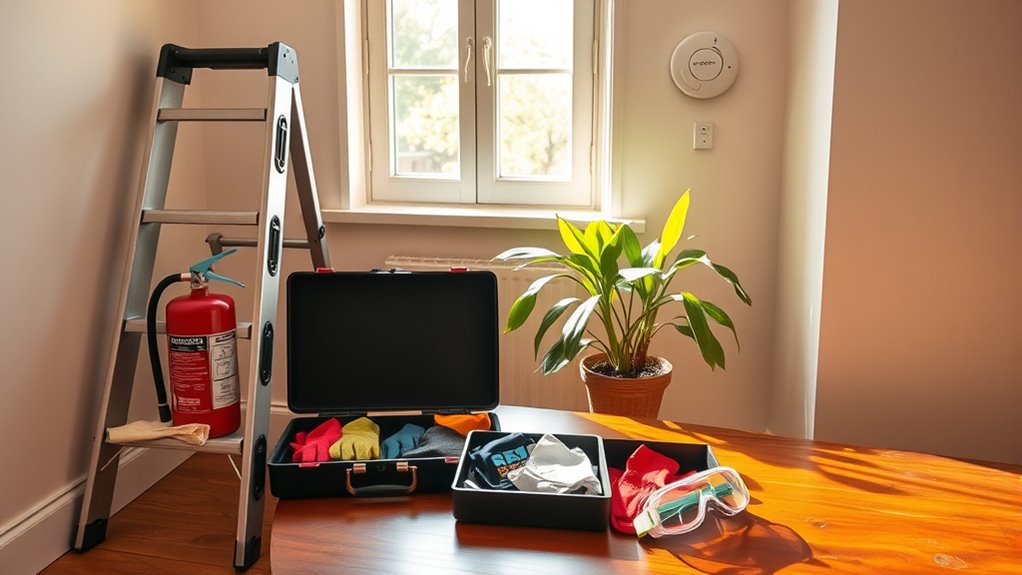
Making certain your home is safe should be a priority during your spring cleaning routine. Start by inspecting fire extinguishers to confirm they’re fully charged and accessible. It’s wise to contemplate adding one in the kitchen and garage for extra safety. Next, check the batteries in smoke detectors and carbon monoxide detectors; replace them if they’re expired or low on power. Additionally, consider installing a home security system to enhance your safety, as the average cost ranges from $200 to $1,500 for installation. Regularly maintaining safety equipment is crucial for optimal performance to ensure they work effectively when needed. Test their functionality by pressing the test button to verify alarms sound correctly. Furthermore, adding best home security systems can provide reliable protection and peace of mind. Don’t forget to review your home safety plan with your family, including escape routes and emergency contacts. Keeping everyone informed can make a significant difference in an emergency. By taking these steps, you’ll help create a safer home for you and your loved ones. Additionally, consider installing a home security system to enhance your overall safety and deter potential threats.
Prepare Your Cleaning Area
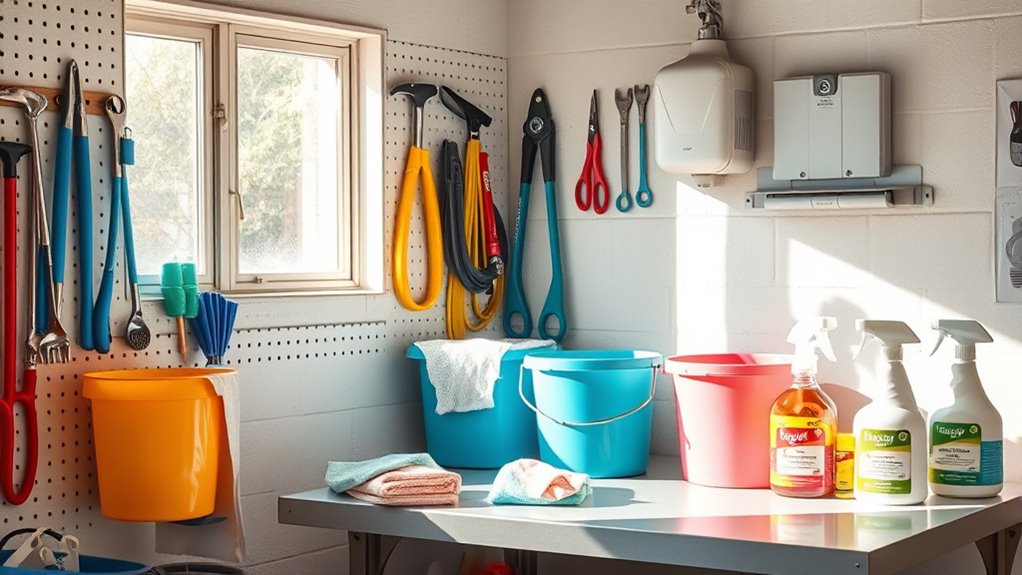
To kick off your spring cleaning, gather all your cleaning supplies in one efficient spot. Decluttering and organizing your cleaning area will save you time and make the process smoother. Additionally, having a dedicated space for your cleaning supplies can also help you maintain an organized environment, just like having a well-structured backyard greenhouse allows for better gardening practices. Using eco-friendly options for cleaning can also contribute to a healthier home environment during your spring cleaning efforts. Regularly cleaning your tools and supplies can enhance their effectiveness and longevity, similar to how professional cleaning methods ensure optimal results.
Gather Cleaning Supplies Efficiently
A well-organized cleaning area can make all the difference when preparing for spring cleaning. Start by creating a checklist of essential cleaning products, including natural cleaners like vinegar and baking soda, microfiber cloths, and scrub brushes.
Designate a central cleaning station in your home for easy access to your supplies.
To maximize efficiency, organize your cleaning supplies in a caddy or basket, grouping similar items together:
- Dusting supplies
- Bathroom cleaners
- Kitchen cleaners
- Specialty tools (like a vacuum with attachments)
Ensure your cleaning area is well-lit and free of clutter, creating a motivating environment for an efficient clean.
With everything in place, you’ll be ready to tackle your spring cleaning tasks with ease!
Declutter Your Cleaning Space
Decluttering your cleaning space is an essential step in preparing for an effective spring cleaning session.
Start by designating a specific area for your cleaning supplies, making essential tools like brooms and all-purpose cleaners easily accessible. Organize your cleaning products by type, placing frequently used items in the front and less common ones in the back to streamline your routine.
Safely dispose of any expired or unused products to minimize clutter and enhance your cleaning efficiency. Incorporate storage solutions like caddies or baskets to keep smaller items organized and portable, allowing you to move around your home seamlessly.
Finally, maintain a checklist of necessary cleaning supplies, ensuring you have everything ready before diving into your spring cleaning efforts.
Organize Cleaning Tools Systematically
Having established a designated cleaning space, it’s time to organize your cleaning tools systematically. Gather all your cleaning supplies—like all-purpose cleaners, microfiber cloths, sponges, and brushes—and store them in your designated cleaning caddy for quick access.
To streamline your spring cleaning process, group items based on their use:
- Surface cleaners
- Bathroom supplies
- Floor care products
- Laundry essentials
Clearly label storage containers or shelves for each category, so you can easily find what you need.
Additionally, prepare a cleaning checklist that aligns with your organized tools. This will help you track tasks and guarantee you have all necessary supplies for each area of your home, making your spring cleaning efficient and enjoyable.
Create a Checklist of Tasks

To make your spring cleaning effective, start by prioritizing essential tasks that cover every corner of your home.
As you sort and declutter items, create designated boxes for what you want to keep, donate, or discard.
Don’t forget to allocate realistic time for each task to keep yourself on track and avoid feeling overwhelmed.
Prioritize Essential Tasks
As you plunge into spring cleaning, creating a prioritized checklist can make the process more manageable and efficient.
Think of cleaning as an opportunity to refresh your home. Your Spring Cleaning Checklist should include once-a-year tasks to tackle during your deep spring cleaning.
Consider these essential tasks:
- Deep-clean carpets and wash windows
- Rotate mattresses and wash bedding
- Declutter and organize pantry items
- Power wash siding and clean gutters
Sort and Declutter Items
Sorting and decluttering items is a crucial step in your spring cleaning journey. Start by designating separate boxes or bags for each category: keep, donate, sell, and discard.
Tackle one room at a time to avoid feeling overwhelmed, focusing first on high-traffic areas like your living room and kitchen. Set a timer for 15 to 30 minutes to keep your sessions short and productive.
Use the “one-year rule”—if you haven’t used an item in the past year and it’s not essential or sentimental, it’s time to let it go.
Involve family members in the process to make decisions easier and foster a shared commitment to maintaining a tidy home.
Happy decluttering!
Allocate Time for Cleaning
Creating a checklist of tasks is essential for effective spring cleaning, ensuring you cover every area of your home efficiently.
To allocate time wisely, start by listing all necessary tasks and breaking them down into manageable segments. This thorough spring cleaning plan will help you stay organized and motivated.
Consider these tips:
- Prioritize tasks based on urgency and importance
- Set aside dedicated days or weekends for specific areas
- Use a checklist format to track progress
- Allocate specific time slots for larger jobs
Involve Family Members

To make spring cleaning a more enjoyable experience, involve your family members in the process. Assign specific cleaning tasks based on each person’s age and abilities, ensuring everyone shares in the homeownership responsibilities.
Create a fun cleaning schedule or checklist that outlines everyone’s duties, making it easier to track progress and motivate participation. Turn cleaning into a family activity by playing music or timing quick cleaning bursts, making tasks feel less intimidating.
Make spring cleaning enjoyable by creating a fun checklist and playing music to keep everyone motivated and engaged.
Encourage family members to declutter their own spaces by providing sorting boxes for items to keep, donate, or discard.
Finally, celebrate your collective efforts with a treat or outing after completing the cleaning, reinforcing teamwork and making the experience more rewarding for everyone.
Frequently Asked Questions
How to Start Your Spring Cleaning?
To start your spring cleaning, create a detailed checklist of tasks for each room, ensuring nothing gets overlooked.
Declutter first by sorting items into keep, donate, and discard piles.
Gather all your cleaning supplies like all-purpose cleaners and microfiber cloths before diving in.
Break your cleaning into manageable sessions, dedicating specific times to different areas.
Involve family members to share the workload and make the process more enjoyable and efficient.
What Is the 20 Minute Rule in Cleaning?
The 20 Minute Rule in cleaning encourages you to dedicate just 20 minutes each day to tackle specific tasks.
By setting a timer, you can focus on one area without feeling overwhelmed. This technique helps you prioritize high-impact chores and maintain momentum, making cleaning feel manageable.
It prevents burnout by breaking larger projects into bite-sized tasks, allowing you to see progress over time and keep your space tidy and organized.
How Do I Declutter My House for Spring?
To declutter your house for spring, start by sorting items into “keep,” “donate,” and “trash” boxes.
Focus on high-traffic areas like closets and junk drawers first to feel accomplished.
Use the “one in, one out” rule to prevent future clutter and apply the “12-month rule” to evaluate unused items.
Schedule regular decluttering sessions, either monthly or seasonally, to keep your space organized and manageable.
You’ll feel refreshed and ready for the new season!
What Does a Professional Spring Clean Include?
A professional spring clean includes a thorough deep cleaning of every room in your home.
You’ll find experts tackling overlooked areas like baseboards and ceiling fans. They focus on your kitchen, scrubbing cabinets, and cleaning appliances, while bathrooms get special attention with detailed scrubbing and organizing.
Window cleaning is also part of the service, ensuring both the inside and outside shine.
Many services offer customizable plans, so you can tailor the cleaning to your needs.
Conclusion
As you embrace the fresh beginnings of spring, balancing the chaos of clutter with the calm of a clean home is essential. By taking the time to prepare and involve your family, you transform a challenging task into a shared experience. With a well-organized plan in hand, you’ll find that the effort put into decluttering and cleaning not only rejuvenates your space but also revitalizes your spirit, creating a harmonious environment for all.

